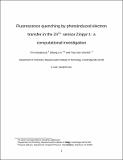Fluorescence quenching by photoinduced electron transfer in the Zn[superscript 2+] sensor Zinpyr-1: a computational investigation
Author(s)
Kowalczyk, Timothy Daniel; Lin, Ziliang; Van Voorhis, Troy
DownloadKowalczykVanVoorhis10.pdf (581.0Kb)
PUBLISHER_POLICY
Publisher Policy
Article is made available in accordance with the publisher's policy and may be subject to US copyright law. Please refer to the publisher's site for terms of use.
Alternative title
Fluorescence quenching by photoinduced electron transfer in the Zn2+ sensor Zinpyr-1: a computational investigation
Terms of use
Metadata
Show full item recordAbstract
We report a detailed study of luminescence switching in the fluorescent zinc sensor Zinpyr-1 by density functional methods. A two-pronged approach employing both time-dependent density functional theory (TDDFT) and constrained density functional theory (CDFT) is used to characterize low-lying electronically excited states of the sensor. The calculations indicate that fluorescence activation in the sensor is governed by a photoinduced electron transfer mechanism in which the energy level ordering of the excited states is altered by binding Zn2+. While the sensor is capable of binding two Zn2+ cations, a single Zn2+ ion appears to be sufficient to activate moderate fluorescence in aqueous solution at physiological pH. We show that it is reasonable to consider the tertiary amine as the effective electron donor in this system, although the pyridyl nitrogens each contribute some density to the xanthone ring. The calculations illustrate an important design principle: because protonation equilibria at receptor sites can play a determining role in the sensor’s fluorescence response, receptor sites with a pKa near the pH of the sample are to be disfavored if a sensor governed by a simple PET fluorescence quenching model is desired.
Date issued
2010-09Department
Massachusetts Institute of Technology. Department of ChemistryJournal
Journal of Physical Chemistry A
Publisher
American Chemical Society
Citation
Kowalczyk, Tim, Ziliang Lin, and Troy Van Voorhis. “Fluorescence Quenching by Photoinduced Electron Transfer in the Zn[superscript 2+] Sensor Zinpyr-1: A Computational Investigation.” The Journal of Physical Chemistry A 114.38 (2010): 10427–10434.
Version: Author's final manuscript
ISSN
1089-5639
1520-5215